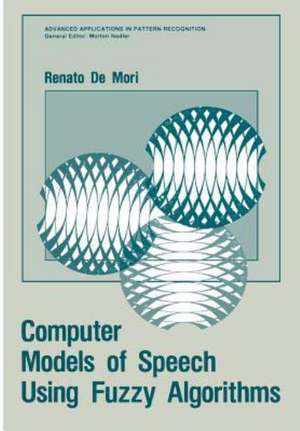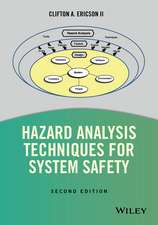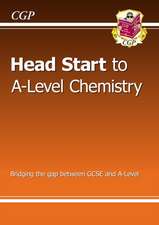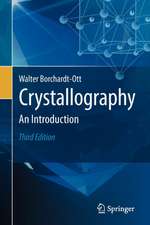Computer Models of Speech Using Fuzzy Algorithms: Advanced Applications in Pattern Recognition
Autor Renato Demorien Limba Engleză Paperback – 3 noi 2011
Preț: 404.67 lei
Nou
Puncte Express: 607
Preț estimativ în valută:
77.44€ • 82.80$ • 64.56£
77.44€ • 82.80$ • 64.56£
Carte tipărită la comandă
Livrare economică 18 aprilie-02 mai
Preluare comenzi: 021 569.72.76
Specificații
ISBN-13: 9781461337447
ISBN-10: 1461337445
Pagini: 512
Ilustrații: XXVI, 482 p.
Dimensiuni: 170 x 244 x 27 mm
Greutate: 0.81 kg
Ediția:Softcover reprint of the original 1st ed. 1983
Editura: Springer Us
Colecția Springer
Seria Advanced Applications in Pattern Recognition
Locul publicării:New York, NY, United States
ISBN-10: 1461337445
Pagini: 512
Ilustrații: XXVI, 482 p.
Dimensiuni: 170 x 244 x 27 mm
Greutate: 0.81 kg
Ediția:Softcover reprint of the original 1st ed. 1983
Editura: Springer Us
Colecția Springer
Seria Advanced Applications in Pattern Recognition
Locul publicării:New York, NY, United States
Public țintă
ResearchCuprins
1. Computer Models for Speech Understanding.- 1.1 Motivations for speech understanding researches.- 1.2 Tasks, difficulties and types of models.- 1.3 A passive model for automatic speech recognition.- 1.4 Active models for speech understanding.- 1.5 On the use of fuzzy set theory.- 1.6 The structure of the book.- 2. Generation and Recognition of Acoustic Patterns.- 2.1 Speech generation.- 2.2 Techniques for generating acoustic patterns.- 2.3 Background on syntactic pattern recognition.- 2.4 Acoustic Cue Extraction for Speech Patterns.- 2.5 Classification of speech patterns.- 2.6 Automatic recognition of continuous speech.- 2.7 References.- 3. On the Use of Syntactic Pattern Recognition and fuzzy Set Theory.- 3.1 Introduction and motivations.- 3.2 The syntactic (structural) approach to the interpretation of speech patterns.- 3.3 The syntax for the recognition of the phonetic feature “vocalic”.- 3.4 Background on fuzzy set theory.- 3.5 Fuzzy relations and languages.- 3.6 Use of fuzzy algorithms for feature hypothesization.- 3.7 References.- 4. Design Principles for Controlling the Use of Structural Rules for Segmentation.- 4.1 The meaning of the meaning.- 4.2 The control problem in the segmentation process.- 4.3 Computation with linguistic probabilities.- 4.4 Segmentation of continuous speech into pseudo-syllabic nuclei.- 4.5 A parallel processing model for generating phoneme hypotheses.- 4.6 A review of previous work on phoneme recognition.- 4.7 References.- 5. Rules for Characterizing Sonorant Sounds.- 5.1 A fragmant of the structural knowledge source for pseudo-syllables.- 5.2 Extraction of detailed spectral features for sonorant sounds.- 5.3 Generation of hypotheses about vowels.- 5.4 Use of formants for the recognition of liquids and nasals.- 5.5 Detailedrecognition of nasal sounds.- 5.6 Structure of the procedural knowledge.- 5.7 References.- 6. Rules for Characterizing the Nonsonorant Sounds.- 6.1 Introduction.- 6.2 Recognition of the phonetic features of nonsonorant sounds.- 6.3 Bottom-up generation of phonemic hypotheses of plosive sounds.- 6.4 Rules for the recognition of plosive sounds.- 6.5 Experimental results.- 6.6 References.- 7. The Lexical Knowledge Source.- 7.1 Word recognition in continuous speech.- 7.2 Dynamic programming for matching word patterns of quasi-continuous feature vectors.- 7.3 Matching speech states.- 7.4 Word detection by the hypothesize-and-test paradigm.- 7.5 The lexical component as a problem solver.- 7.6 The structure of the lexical knowledge.- 7.7 Strategies for lexical access.- 7.8 Selection of candidates and hypothesis evaluation.- 7.9 Strategies for the generation of lexical hypotheses.- 7.10 References.- 8. On the Structure and Use of Task-Dependent Knowledge.- 8.1 Introduction.- 8.2 Finite-state language models.- 8.3 Measuring evidences.- 8.4 Search strategies.- 8.5 On the use of production systems for problem solving.- 8.6 Scheduling of interpretation processes based on approximate reasoning.- 8.7 Outline of a semantically-guided use of task-dependent knowledge.- 8.8 Evaluating language complexity.- 8.9 Review of recent work on task-dependent knowledge.- 8.10 References.- 9. Automatic Learning of Fuzzy Relations.- 9.1 Introduction.- 9.2 Formal definition of the problem and an example of application.- 9.3 A simple preliminary learning case.- 10. Towards a Parallel System.- 10.1 A new model for lexical access.- 10.2 Description of acoustic cues.- 10.3 The knowledge of the descriptor of the global spectral features.- 10.4 Conclusions.













